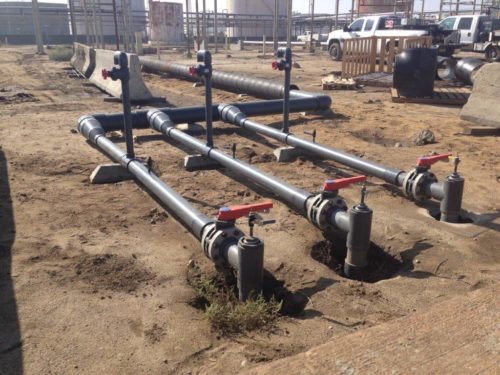 This is a quick introduction to subsurface remediation, specifically, Soil Vapor Extraction and Vapor Treatment. Basically, this term refers to the process of pulling harmful compounds out of the ground (soil or water) and treating the compounds so they can be safely discharged to the atmosphere. These harmful compounds come from leaking underground storage tanks, oil spills, chemical leaks and old dumping sites. Soil Vapor Extraction and Treatment allows removal and on-site destruction of these compounds without having to dig up and handle the contaminated soil.
This is a quick introduction to subsurface remediation, specifically, Soil Vapor Extraction and Vapor Treatment. Basically, this term refers to the process of pulling harmful compounds out of the ground (soil or water) and treating the compounds so they can be safely discharged to the atmosphere. These harmful compounds come from leaking underground storage tanks, oil spills, chemical leaks and old dumping sites. Soil Vapor Extraction and Treatment allows removal and on-site destruction of these compounds without having to dig up and handle the contaminated soil.
There are three basic steps to remediating a site: Extracting (Vapor Extraction) the compounds from the ground, Separating (Water/Liquid Removal) the liquid constituents and Treating (Vapor Treatment) the contaminants so they are harmless to the environment.
Vapor Extraction
Soil Vapor Extraction (SVE) is an in situ (in the soil) remediation process that removes the contaminants from the ground. The term vacuum extraction references the fact that the contaminants are pulled out of the soil with a vacuum-like process. It allows us to treat the contaminants without having to excavate and haul the soil from the site to a landfill.
The contaminants are Volatile Organic Compounds (VOCs). An organic compound is considered volatile if it produces a vapor (a gas) at room temperature and normal atmospheric pressure (think of the fumes you see on gasoline pumps without vapor recovery nozzles). Some of these vapors are dangerous to humans when inhaled in great quantities or over a long period of time, and also form harmful ozone.
The volatility of the compounds is what makes them so dangerous, but it is also the reason we can treat them. An extraction system uses a powerful vacuum and a network of wells to pull the volatile compounds out of the soil. The extraction process involves digging wells into the ground and connecting the extraction system to the wells. With the tremendous pull of the vacuum, the volatile compounds readily move toward the wells while the heavier soil stays in place.
Remedial
The diagram above shows how the air moves towards the wells. Each well has a Radius of Influence (ROI) determined by the vacuum and the soil conditions. For example, a very sandy and porous soil will likely have a larger Radius of Influence (ROI) than tight clay, or any other nonporous soil. Wells are often placed in a site to cover the maximum amount of contaminated space with the minimum number of wells. There are many factors that influence the type of extraction system that is required. These factors are interconnected and impact one another: the size of the plume (the contaminated area), the number of wells, the placement of wells, the soil conditions, the time constraints, the contaminant concentrations and the pilot test results. An environmental engineer will assess these factors.
Water/Liquid Removal
When the contaminants are pulled from the ground, they often carry with them the moisture that was present in the soil or the water table and needs to be separated. The air and entrained water come up from the wells and spins around a cylindrical knockout pot. Internal baffles in the pot help the centrifugal force separate the water from the air. On its way to the blower and the treatment device, the air rises in the pot and passes through a mist eliminator, a thick mesh of stainless steel. As the air passes through the steel mesh, additional water droplets collect. As more moisture collects, the water forms heavy beads that drop to the bottom of the pot. The amount of water that is collected varies greatly from site to site based on the depth of the local water table and the amount of rainfall. A large volume of water, for instance, may necessitate further treatment.
The air that remains consists of the VOCs pulled from the subsurface. These VOCs are just as harmful to the air as they were to the water table, so they cannot be pumped into the atmosphere. First, they must be treated.
Vapor Treatment
Often, the most effective way to treat the airstream containing VOCs is to oxidize them. Oxidation causes compounds to break up and re-form into new (in this case, safe) compounds. Add the right amount of heat and oxygen and oxidation occurs (the process is Cn H2m + (n + m/2) O2 Þ n CO2 + H2O + Heat)
Breaking the harmful compounds into harmless compounds and energy is the basic premise to all oxidation technologies. In the thermal oxidation process, the contaminated air is heated, breaking apart the contaminated compounds. The compounds will re-form naturally, bonding into the harmless compounds of carbon dioxide and water vapor while also releasing energy. During catalytic oxidation, the contaminated compounds in the air react with a catalyst material (platinum, palladium, rhodium, etc.) which helps break apart the VOCs at a lower temperature than thermal oxidation.
After the VOCs have been oxidized, the air can be discharged into the atmosphere. The remediation process is now complete: the VOCs have been extracted from the area that was contaminated, liquid constituents have been separated, and the VOCs have been turned into harmless compounds.
